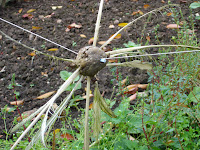The beautiful Avon river:
 Outside the tourist centre:
Outside the tourist centre: There are 5 houses relating to Shakespeare's life scattered throughout the town, owned and operated by the Shakespeare Birthplace Trust. We dutifully made our way around them all, taking a tourist bus here and there. The first is on Henley Street, where John Shakespeare bought a half-timbered Tudor farm house in 1556. William was born here in 1564.
There are 5 houses relating to Shakespeare's life scattered throughout the town, owned and operated by the Shakespeare Birthplace Trust. We dutifully made our way around them all, taking a tourist bus here and there. The first is on Henley Street, where John Shakespeare bought a half-timbered Tudor farm house in 1556. William was born here in 1564. It's a very pretty little cottage, with a lovely garden planted with herbs and flowers referred to in Shakespeare's plays and poems. The interiors have been kept in period, but it was hard to get the atmosphere with so many fellow tourists shuffling about.
It's a very pretty little cottage, with a lovely garden planted with herbs and flowers referred to in Shakespeare's plays and poems. The interiors have been kept in period, but it was hard to get the atmosphere with so many fellow tourists shuffling about.

 The Americans have built a Shakespeare monument by the market square. It doesn't evoke much to me, but it does have some nice carvings on it - little animals and monsters and the like.
The Americans have built a Shakespeare monument by the market square. It doesn't evoke much to me, but it does have some nice carvings on it - little animals and monsters and the like. The second of our stops was Anne Hathaway's Cottage at Shottery, the home of Shakespeare's wife's family prior to her marriage.
The second of our stops was Anne Hathaway's Cottage at Shottery, the home of Shakespeare's wife's family prior to her marriage.
 There was a little orchard, though the fruit wasn't yet in season. Nonetheless I did try an apple (crunchy, but tart), a pear (too hard to eat) and a quince (hideously dry in the mouth).
There was a little orchard, though the fruit wasn't yet in season. Nonetheless I did try an apple (crunchy, but tart), a pear (too hard to eat) and a quince (hideously dry in the mouth). This is authentic Tudor bird-scaring device - a potato stuck with feathers that rotates on a string.
This is authentic Tudor bird-scaring device - a potato stuck with feathers that rotates on a string. Further out in the countryside is stop number 3, Mary Arden's House, the family home of Shakespeare's mother. This is well worth the stop, with lots of farmyard animals, including plenty of chooks, sheep and even some birds of prey.
Further out in the countryside is stop number 3, Mary Arden's House, the family home of Shakespeare's mother. This is well worth the stop, with lots of farmyard animals, including plenty of chooks, sheep and even some birds of prey.
 Back in town we stopped at #4, Nash's House. This is built beside the site of New Place, a mansion-like complex built by Shakespeare at the height of his fortune. He lived and died here, but alas!, the site was demolished by Nash in a dispute over taxes. Afterwards we we wandered through the theatre quarter, where the Royal Shakespeare Company operate.
Back in town we stopped at #4, Nash's House. This is built beside the site of New Place, a mansion-like complex built by Shakespeare at the height of his fortune. He lived and died here, but alas!, the site was demolished by Nash in a dispute over taxes. Afterwards we we wandered through the theatre quarter, where the Royal Shakespeare Company operate.Boats in the Avon river named after female characters from Shakespeare's plays:

 Brass rubbing centre:
Brass rubbing centre: Holy Trinity Church, where Shakespeare was baptised and is buried. The present building dates from 1210 and is built on the site of a Saxon monastery. It is Stratford's oldest building, in a striking position on the banks of the River Avon, and has long been England's most visited parish church.
Holy Trinity Church, where Shakespeare was baptised and is buried. The present building dates from 1210 and is built on the site of a Saxon monastery. It is Stratford's oldest building, in a striking position on the banks of the River Avon, and has long been England's most visited parish church.
 It is said that Shakespeare's body is buried 20 feet deep to prevent its theft. Above the grave, a badly eroded stone slab displays his epitaph:
It is said that Shakespeare's body is buried 20 feet deep to prevent its theft. Above the grave, a badly eroded stone slab displays his epitaph:Good friend, for Jesus' sake forbear,
To dig the dust enclosèd here.
Blest be the man that spares these stones,
But cursed be he that moves my bones.
 A 14th-century sanctuary knocker in the church's porch (built c. 1500):
A 14th-century sanctuary knocker in the church's porch (built c. 1500): Hall's Croft, the one-time home of Shakespeare's daughter, Susannah, and her husband Dr John Hall. Outside is a large mulberry tree, grown from a cutting off Shakespeare's own mulberry tree. Obscure!
Hall's Croft, the one-time home of Shakespeare's daughter, Susannah, and her husband Dr John Hall. Outside is a large mulberry tree, grown from a cutting off Shakespeare's own mulberry tree. Obscure! In the evening we went to see the Royal Shakespeare Company production of Henry V. It was brilliantly staged, but very tiring as we only had standing 'seats'.
In the evening we went to see the Royal Shakespeare Company production of Henry V. It was brilliantly staged, but very tiring as we only had standing 'seats'.
No comments:
Post a Comment